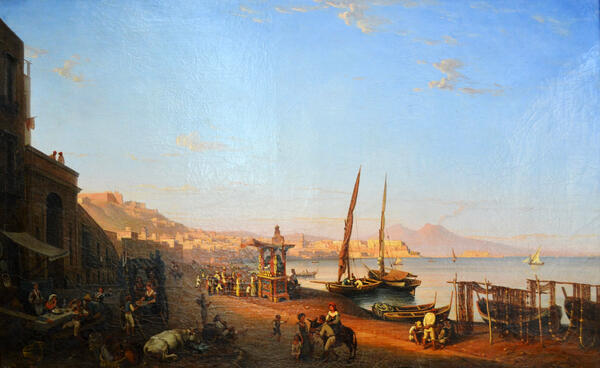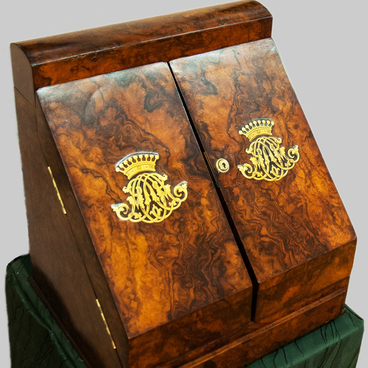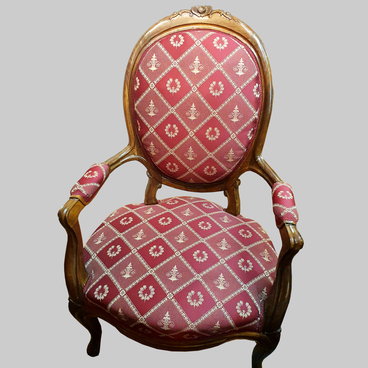The painting ‘View of Naples’ came to the Ramenskoye History and Art Museum from the Bronnitsky Museum in 1930. It is probable that the work had previously been kept in one of the nationalized estates of the Bronnitsy District.
The author of the canvas, Gabriele Smargiassi, was born on July 22, 1798. He came from a wealthy family. Relatives expected him to follow in the footsteps of his uncle and become a priest. However, Gabriele decided to be an artist, and at the age of 19, he moved to Naples. He was apprenticed to Giuseppe Cammarano, professor at the Academy of Fine Arts and court painter for the House of Bourbon-Two Sicilies. Having received an artist’s scholarship and the right to permanent residence in the city, Smargiassi studied in Rome from 1824 to 1828.
Between 1827 and 1837, the artist lived in Paris, where he was invited as an art tutor for the future emperor of France. His regularly participated in the Salon with his landscapes of Naples and Rome. Smargiassi also exhibited French vedutas, meaning paintings or drawings featuring a detailed view of an everyday urban landscape and architectural monuments. Around that time, he also created a portrait of Pope Leo XII.
In 1837, Antonie Pitloo, head of the landscape department at the Neapolitan Academy and Gabriele’s teacher, died. The Academy announced a competition to fill the vacant position, which was subsequently won by Smargiassi. He became the head of the department and moved to Naples.
It was during this period that the artist created the canvas ‘View of Naples from the Coast of Mergellina’ displayed here. The painting marks the beginning of a new series of idealized historical compositions.
It is a traditional landscape that was highly acclaimed by collectors and enjoyed commercial success.
‘View of Naples from the Coast of Mergellina’ depicts a wide expanse of the bay featuring the medieval fortress of Castel dell’Ovo and the smoking Vesuvius in the background. The foreground is enlivened by scenes of everyday life.
Their fleetingness successfully captures fragments of reality. The foreground features a scene with a market stall covered by an awning.
Drying fishing nets can be seen hanging by a group of fishermen.
Children are playing on the road, small boats are sailing in the calm sea, and no one in this entire image feels time rushing forward.
The author of the canvas, Gabriele Smargiassi, was born on July 22, 1798. He came from a wealthy family. Relatives expected him to follow in the footsteps of his uncle and become a priest. However, Gabriele decided to be an artist, and at the age of 19, he moved to Naples. He was apprenticed to Giuseppe Cammarano, professor at the Academy of Fine Arts and court painter for the House of Bourbon-Two Sicilies. Having received an artist’s scholarship and the right to permanent residence in the city, Smargiassi studied in Rome from 1824 to 1828.
Between 1827 and 1837, the artist lived in Paris, where he was invited as an art tutor for the future emperor of France. His regularly participated in the Salon with his landscapes of Naples and Rome. Smargiassi also exhibited French vedutas, meaning paintings or drawings featuring a detailed view of an everyday urban landscape and architectural monuments. Around that time, he also created a portrait of Pope Leo XII.
In 1837, Antonie Pitloo, head of the landscape department at the Neapolitan Academy and Gabriele’s teacher, died. The Academy announced a competition to fill the vacant position, which was subsequently won by Smargiassi. He became the head of the department and moved to Naples.
It was during this period that the artist created the canvas ‘View of Naples from the Coast of Mergellina’ displayed here. The painting marks the beginning of a new series of idealized historical compositions.
It is a traditional landscape that was highly acclaimed by collectors and enjoyed commercial success.
‘View of Naples from the Coast of Mergellina’ depicts a wide expanse of the bay featuring the medieval fortress of Castel dell’Ovo and the smoking Vesuvius in the background. The foreground is enlivened by scenes of everyday life.
Their fleetingness successfully captures fragments of reality. The foreground features a scene with a market stall covered by an awning.
Drying fishing nets can be seen hanging by a group of fishermen.
Children are playing on the road, small boats are sailing in the calm sea, and no one in this entire image feels time rushing forward.



